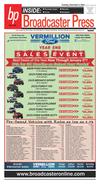4.pdf






04 Broadcaster Press
Researcher’s work is ‘for the birds’
By Travis Gulbrandson
travis.gulbrandson@plaintalk.net
An ongoing research
project at the University of
South Dakota aims to
determine how birds
respond physiologically to
changes in their
environment.
Far from being a local
interest-only situation, the
results yielded by the
project could have
implications for the study
of global climate change.
“If we know how birds
respond to those changing
temperatures, changing
photoperiods, then we can
make some predictions
about how birds will be
able to respond (to
changes in climate) and
whether they can
withstand those changes,”
said Dr. David Swanson,
professor of biology at
USD.
The project was started
at USD by Swanson in
1990, and concerned the
physical changes the birds
undergo season to season.
The metabolic rates of
birds that stayed in the
area all year, as well as only
part of the year, were
studied because the total
amount of energy a bird
uses is directly related to
its heat production.
“We looked at what
their maximal capacity for
heat production was in the
summer, and compared
that with their maximal
capacity for heat
production in the winter,”
Swanson said. “What we
found was that the winter
birds generally had higher
maximal heat production
than summer birds by
about 25-50 percent on
average. That enabled
them to survive a lot
colder temperatures than
the summer birds could.”
Heat production in
birds is primarily the
function of the skeletal
muscles, specifically their
flight muscles, although
Swanson points out that
muscle growth isn’t related
Spotlight
On
to the amount of time the
birds spend flying.
“If anything, they’re
probably flying around a
lot less (during the winter)
because they’re not taking
trips back and forth to the
nest,” he said. “But they’re
shivering like crazy, so heat
production in birds is
(caused) primarily by
shivering with those big
flight muscles.
“The bigger muscles
allow them to increase
their shivering capacity,
and that allows them to
increase their cold
tolerance,” he said.
The USD researchers
now are looking into the
factors that regulate
seasonal changes in muscle
size, in particular a protein
called myostatin, which is
a muscle growth inhibitor.
“What we were
hypothesizing was that this
myostatin gene was downregulated in the winter,
and so … that would free
up the muscle to grow,”
Swanson said.
Tests on house sparrows
showed that the gene was
decreased by 55 percent in
the winter, and the
capacity for activating
myostatin also was
reduced, he said.
A broad spectrum of
natural changes is being
studied, as well.
“We’re looking at it in
several other wintering
species,” Swanson said.
“We’re also looking for
changes in myostatin in
migration because …prior
to engaging in migration
birds get bigger muscles,
and that helps to support
their migratory flights.”
Swanson said it will be
interesting to see if it
shows the same results as
the regular change of
seasons, as well as the
switch from longer to
shorter days.
“That should tell us if
it’s really a general
mechanism that birds use
to regulate change in their
muscle size whenever they
need those changes,” he
said.
The results of these and
other tests could give the
researchers insight into the
global issue of climate
change.
“If the habitats that
they need and the
temperatures that they can
tolerate become
mismatched, then there
could be some potential
problems for the
populations of these
birds,” Swanson said.
Studies like the one at
USD could give researchers
a better idea of how and if
the birds will acclimate to
long-term change, he said.
In addition, there also
could be positive
outgrowths for humans.
Swanson said that while
it isn’t a specific interest of
the USD project, one
possible spinoff is in the
field of muscle-wasting
diseases such as muscular
dystrophy.
“The role of myostatin
in some of those diseases is
actually being targeted by
some research to look at
potential treatments,” he
said.
For more information
about Swanson and his
research, visit
http://people.usd.edu/~dls
wanso/.
February 05, 2013 www.broadcasteronline.com
Sanford/USD
awarded Magnet
recognition
For the thirdconsecutive time,
Sanford/USD Medical
Center has achieved
Magnet® recognition as
part of the American
Nurses Credentialing
Center’s (ANCC) Magnet
Recognition Program,
positioning the institution
in the top 1 percent of
facilities nationwide for
nursing excellence.
Bestowed every four
years, the Magnet
Recognition Program’s
distinction is the highest
honor an organization can
receive for professionalnursing practice. Magnet®
recognition is often
considered when the public
judges health care
organizations. Just 378 of
the United States' nearly
6,000 facilities attained
Magnet® status for this
cycle.
“Magnet recognition is a
prestigious honor that
reflects our commitment to
deliver the highest quality
of care,” said Diana
Berkland, RN, chief
nursing officer at
Sanford/USD Medical
Center. “Our staff pursues
excellence each and every
day – always keeping the
needs of our patients at the
forefront.”
Sanford/USD Medical
Center passed a rigorous
and lengthy process that
demanded widespread
participation from
leadership and staff. The
facility was also required to
submit written
documentation
demonstrating qualitative
and quantitative evidence
regarding patient care and
outcomes, which, when
deemed to be at an
excellent level, prompted
an on-site review. The
ridal Directory
B
Let us help m ake your day
everythin g you’ve dream ed of.
Call Emily to schedule a complimentary
consultation today.
W
Commission on Magnet
then voted to grant
recognition.
Because Sanford/USD
Medical Center was a
Magnet® recipient in 2008,
it was required to provide
how Magnet® concepts,
performance and quality
were sustained and
improved over the past
four years.
The Magnet® model is
designed to provide
framework for nursing
practice and research and
measurement of outcomes.
Elements like quality of
nursing leadership and
coordination, collaboration
across specialties and
processes for measuring
and improving the quality
and delivery of care were
considered for selection.
“Retaining this honor
for another four years is a
testament to our nurses
and nursing leadership and
the quality care they
provide,” said Charles
O’Brien, MD, president of
Sanford/USD Medical
Center. “We strive daily to
become a better institution,
and this award illustrates
that this effort is surely
paying dividends.”
Magnet recognition has
been shown to provide
specific benefits to
hospitals and their
communities:
• Higher patient
satisfaction with nurse
communication,
availability of help, and
receipt of discharge
information;
• lower risk of 30-day
mortality and lower failure
to rescue;
• higher job satisfaction
among nurses; and
• lower nurse reports of
intentions to leave position.
enduring beauty
From first glance to the last
dance, we’ll create a wedding
day look that will continue to
take your guests breath away...
illson Florist
21 W. Main St., Vermillion
605.624.4491
Special Occasions and
Wedding Rentals, Invitations,
Set-Ups & Take Downs
The Looking Glass
902 Eastgate Drive
CALL FOR AN APPOINTMENT
605-624-4587 or 605-660-1931
visit the web at: wedo-weddings.info
“Bringing you the best in
bridal & prom for less!”
The
Bridal
Outlet
1108 W. Cedar St., Beresford, SD
1-855-444-BRIDE
Hours: M-Th 10-6, Fri. & Sat. 10-5








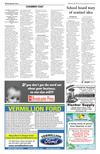

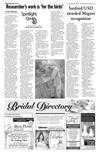


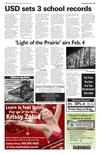
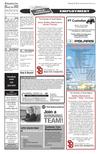

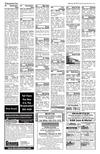
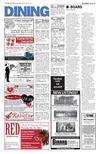

 Previous Page
Previous Page



